
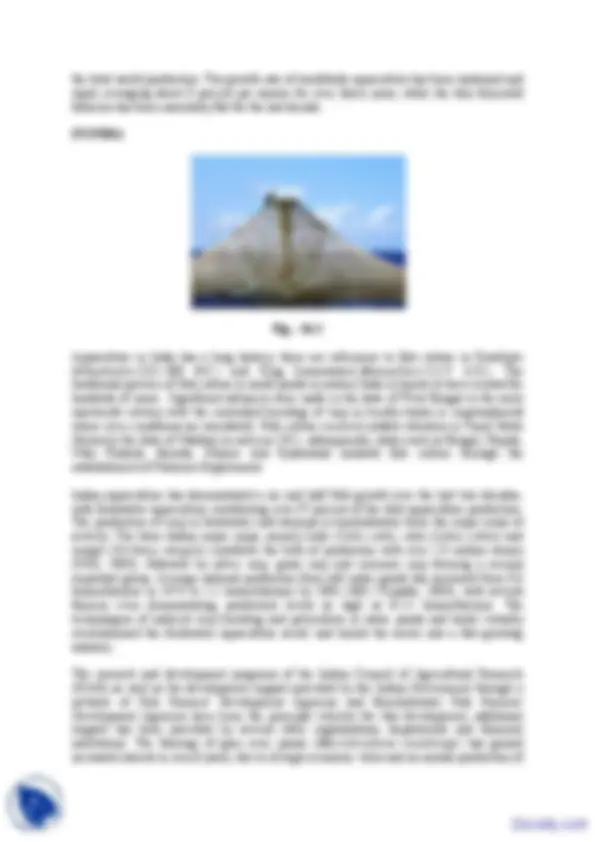
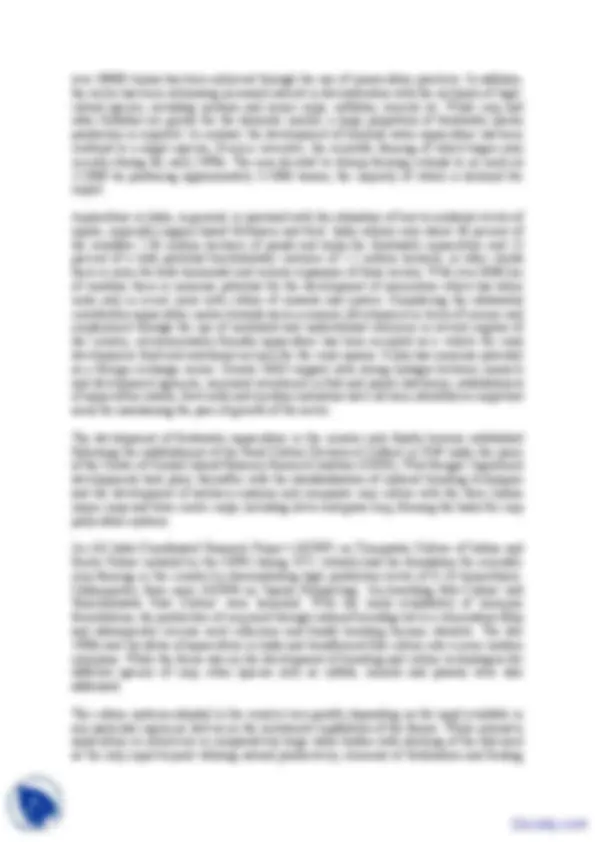
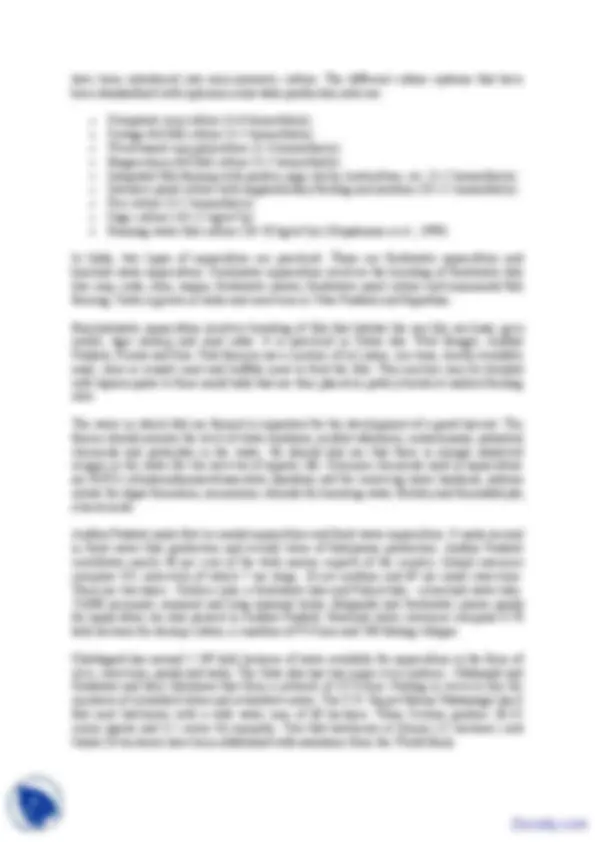
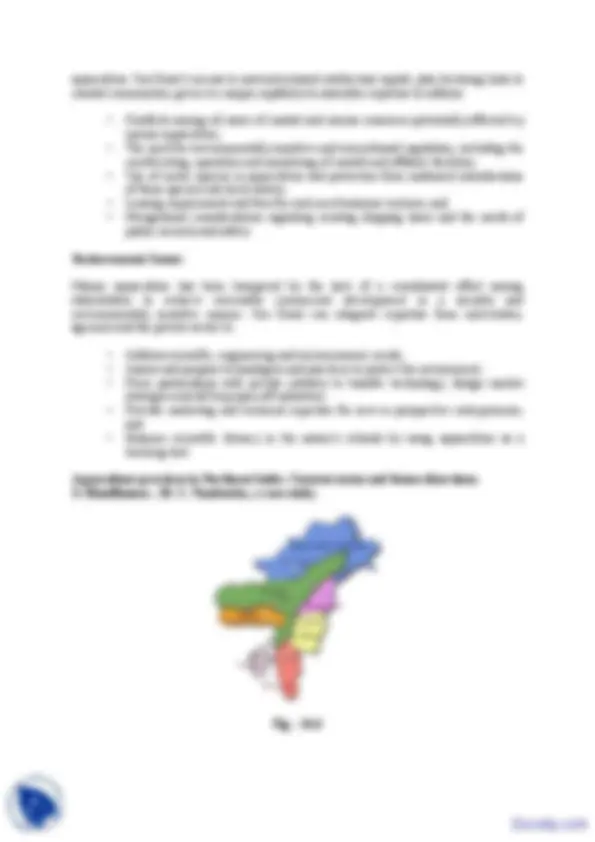
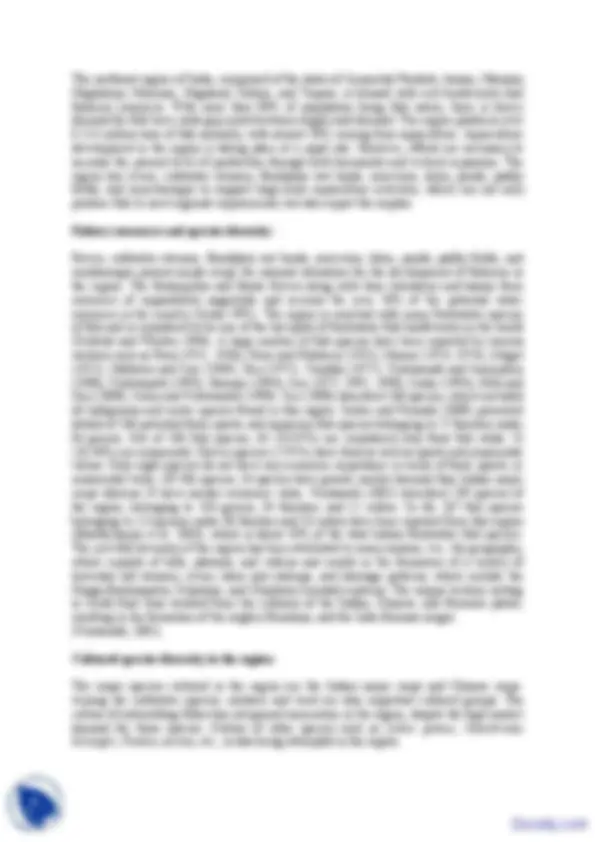



Study with the several resources on Docsity

Earn points by helping other students or get them with a premium plan


Prepare for your exams
Study with the several resources on Docsity

Earn points to download
Earn points by helping other students or get them with a premium plan
Community
Ask the community for help and clear up your study doubts
Discover the best universities in your country according to Docsity users
Free resources
Download our free guides on studying techniques, anxiety management strategies, and thesis advice from Docsity tutors
Environmental Sciences is sub category of Biology study. This lecture note is related to Environment Pollution subject. Main points in this lecture are: Aquaculture, Aqua Farming, Culture System, Policy, Law, Sea Grant, Science Serving, Technology, Development, Marine, Operations
Typology: Study notes
1 / 11

This page cannot be seen from the preview
Don't miss anything!







Fig – 16.
INTRODUCTION
Aquaculture is the farming of freshwater and saltwater organisms as finfish, molluscs, crustaceans and aquatic plants. It is also known as aquafarming. Aquaculture involves cultivating aquatic populations under controlled conditions, and can be contrasted with commercial fishing, which is the harvesting of wild fish. Commercial aquaculture supplies one half of the fish and shellfish that is directly consumed by humans. Aquaculture and agriculture are not strictly parallel developments in food production, even though food gathering, hunting and fishing might have started at about the same time in human history. The complexity of aquaculture as a multi-disciplinary activity, even more complex than agriculture, is perhaps one of the reasons for the late start of modern aquaculture.
HISTORY
Asia, in particular China, has dominated aquaculture developments in the world right through history. The first known ‘Treatise in Fish Culture’ was written by Fan Li in 476 BC. Aquaculture began in China circa 2500 BC. When the waters subsided after river floods, some fishes, mainly carp, were trapped in lakes. Nascent aquaculturists fed their brood using nymphs and silkworm feces, and ate the fish for their protein. A fortunate genetic mutation of carp led to the emergence of goldfish during the Tang Dynasty. While this could be considered as the beginning of traditional aquaculture, China still dominates the world scene by accounting for over 65% global aquaculture production. Though India is second only to China, it accounts for only 7% of global aquaculture production.
Hawaiians practiced aquaculture by constructing fish ponds. A remarkable example is a fish pond dating from at least 1,000 years ago, at Alekoko. Legend says that it was constructed by the mythical Menehune. The Japanese cultivated seaweed by providing bamboo poles and, later, nets and oystershells to serve as anchoring surfaces for spores. The Romans bred fish in ponds.
In central Europe, early Christian monasteries adopted Roman aquacultural practices. Aquaculture spread in Europe during the Middle Ages, since away from the seacoasts and the big rivers, fish were scarce/expensive. Improvements in transportation during the 19th century made fish easily available and inexpensive, even in inland areas, making aquaculture less popular.
In 1859 Stephen Ainsworth of West Bloomfield, New York, began experiments with brook trout. By 1864 Seth Green had established a commercial fish hatching operation at Caledonia Springs, near Rochester, NY. By 1866, with the involvement of Dr. W. W. Fletcher of Concord Mass, artificial fish hatching operations were under way in both Canada and the United States. When the Dildo Island fish hatchery opened in Newfoundland Canada in 1889, it was the largest and most advanced in the world.
GLOBAL AQUACULTURE
Fig – 16.
Global aquaculture production has been steadily increasing over the last decade. The global production of farmed fish and shellfish (according to FAO categorization) increased from 10.64 million metric tonnes (mt) in 1987 to 26.83 million mt in 1996, indicating an increase of 148%. The corresponding increase in value was 110%, from 16.38 billion to US $ 41. billion. The boom in aquaculture production is reflected in the production figures for India as well which shows an increase from 0.78 million mt in 1987 to 1.77 million mt in 1996 (126%), and the corresponding value increase was from 0.83 billion to US $ 1.98 billion (139%). This estimate by FAO might appear conservative when, according to Marine Products Export Development Authority of India (MPEDA), the export earnings from shrimp alone exceeded one billion dollars consecutively for the last four years. Asian countries claim the lion’s share (91%) of global aquaculture production, adopting a spectrum of different culture systems and intensities, from the traditional to the most modern, with other continents trailing behind, some excelling however in production of certain categories of fishes (diadromous fishes), such as salmonids. In 2004, the total world production of fisheries was 140.5 million tonnes of which aquaculture contributed 45.5 million tonnes or about 32% of
over 30000 tonnes has been achieved through the use of monoculture practices. In addition, the sector has been witnessing increased interest in diversification with the inclusion of high- valued species, including medium and minor carps, catfishes, murrels etc. While carp and other finfishes are grown for the domestic market, a large proportion of freshwater prawn production is exported. In contrast, the development of brackish water aquaculture has been confined to a single species, Penaeus monodon , the scientific farming of which began only recently during the early 1990s. The area devoted to shrimp farming extends to as much as 152000 ha producing approximately 115000 tonnes, the majority of which is destined for export.
Aquaculture in India, in general, is practised with the utilisation of low to moderate levels of inputs, especially organic-based fertilisers and feed. India utilises only about 40 percent of the available 2.36 million hectares of ponds and tanks for freshwater aquaculture and 13 percent of a total potential brackishwater resource of 1.2 million hectares, in other words there is room for both horizontal and vertical expansion of these sectors. With over 8000 km of coastline there is immense potential for the development of mariculture which has taken roots only in recent years with culture of mussels and oysters. Considering the substantial contribution aquaculture makes towards socio-economic development in terms of income and employment through the use of unutilised and underutilised resources in several regions of the country, environmentally friendly aquaculture has been accepted as a vehicle for rural development, food and nutritional security for the rural masses. It also has immense potential as a foreign exchange earner. Greater R&D support with strong linkages between research and development agencies, increased investment in fish and prawn hatcheries, establishment of aquaculture estates, feed mills and ancillary industries have all been identified as important areas for maintaining the pace of growth of the sector.
The development of freshwater aquaculture in the country only finally became established following the establishment of the Pond Culture Division at Cuttack in 1949 under the name of the Center of Central Inland Fisheries Research Institute (CIFRI), West Bengal. Significant developments took place thereafter with the standardisation of induced breeding techniques and the development of hatchery systems and composite carp culture with the three Indian major carps and three exotic carps, including silver and grass carp, forming the basis for carp polyculture systems.
An All India Coordinated Research Project (AICRP) on 'Composite Culture of Indian and Exotic Fishes' initiated by the CIFRI during 1971 virtually laid the foundation for scientific carp farming in the country by demonstrating high production levels of 8–10 tonnes/ha/yr. Subsequently, three more AICRPs on 'Spawn Prospecting', 'Air-breathing Fish Culture' and 'Brackishwater Fish Culture' were launched. With the ready availability of hormone formulations, the production of carp seed through induced breeding led to a tremendous fillip and subsequently riverine seed collection and bundh breeding became obsolete. The late 1980s saw the dawn of aquaculture in India and transformed fish culture into a more modern enterprise. While the focus was on the development of breeding and culture technologies for different species of carp, other species such as catfish, murrels and prawns were also addressed.
The culture systems adopted in the country vary greatly depending on the input available in any particular region as well as on the investment capabilities of the farmer. While extensive aquaculture is carried out in comparatively large water bodies with stocking of the fish seed as the only input beyond utilising natural productivity, elements of fertilisation and feeding
have been introduced into semi-intensive culture. The different culture systems that have been standardised with optimum achievable production rates are:
Composite carp culture (4–6 tonnes/ha/yr). Sewage-fed fish culture (3–5 tonnes/ha/yr). Weed-based carp polyculture (3–4 tonnes/ha/yr). Biogas slurry-fed fish culture (3–5 tonnes/ha/yr). Integrated fish farming with poultry, pigs, ducks, horticulture, etc. (3–5 tonnes/ha/yr). Intensive pond culture with supplementary feeding and aeration (10–15 tonnes/ha/yr). Pen culture (3–5 tonnes/ha/yr). Cage culture (10–15 kg/m²/yr). Running-water fish culture (20–50 kg/m²/yr) (Gopakumar et al ., 1999)
In India, two types of aquaculture are practiced. These are freshwater aquaculture and brackish water aquaculture. Freshwater aquaculture involves the breeding of freshwater fish like carp, catla, rohu, magur, freshwater prawn, freshwater pearl culture and ornamental fish farming. Catla is grown in tanks and reservoirs in Uttar Pradesh and Rajasthan.
Brackishwater aquaculture involves breeding of fish that habitat the sea like sea bass, grey mullet, tiger shrimp and mud crabs. It is practiced in States like West Bengal, Andhra Pradesh, Kerala and Goa. Fish farmers use a mixture of oil cakes, rice bran, locally available snail, clam or mussel meat and buffalo meat to feed the fish. This mixture may be blended with tapioca paste to form small balls that are then placed in pottery bowls at marked feeding sites.
The water in which fish are farmed is important for the development of a good harvest. The farmer should monitor the level of water hardness, acidity/ alkalinity, contaminants, industrial chemicals and pesticides in the water. He should also see that there is enough dissolved oxygen in the water for the survival of aquatic life. Common chemicals used in aquaculture are EDTA (ethylenediaminetetraacetate) disodium salt for removing water hardness, sodium nitrate for algae formation, ammonium chloride for boosting water fertility and formaldehyde, a bactericide.
Andhra Pradesh ranks first in coastal aquaculture and fresh water aquaculture. It ranks second in fresh water fish production and overall value of fish/prawn production. Andhra Pradesh contributes nearly 40 per cent of the total marine exports of the country. Inland resources comprise 102 reservoirs of which 7 are large, 26 are medium and 69 are small reservoirs. There are two lakes - Kolleru Lake, a freshwater lake and Pulicat lake - a brackish water lake. 74,000 perennial, seasonal and long seasonal tanks, fishponds and freshwater prawn ponds for aquaculture are also present in Andhra Pradesh. Brackish water resources comprise 0. lakh hectares for shrimp culture, a coastline of 974 kms and 508 fishing villages.
Chattisgarh has around 1.549 lakh hectares of water available for aquaculture in the form of river, reservoirs, ponds and tanks. The State also has two major river systems - Mahanadi and Godawari and their tributaries that form a network of 3573 kms. Fishing in rivers is free for members of scheduled tribes and scheduled castes. The C.G. Rajya Matsya Mahasangh has 6 fish seed hatcheries with a total water area of 60 hectares. These Centres produce 30- crores spawn and 4.5 crores fry annually. Two fish hatcheries at Demar (25 hectares.) and Salud (10 hectares) have been established with assistance from the World Bank.
(2) The Exclusive Economic Zone seafloor; and (3) The open ocean surface and water column. Utilization of each environment presents unique system engineering, technological and security challenges.
Nutrition and Feeds:
Research and development efforts must evaluate feed components in relation to organism growth and final product quality, as well as the stability of formulated rations and alternative protein sources.
Genetics of Cultured Species:
Research must identify gene complexes responsible for reproduction, growth, disease resistance and other desirable traits so that state-of-the-art genetic manipulations can be applied to marine species.
Health and Disease:
Fig – 16.
We must better understand the immune systems of marine organisms and the potential for the production of vaccines in finfish and shellfish. A great need exists for improved diagnostic capabilities for aquatic pathogens and parathe production of vaccines in finfish and shellfish. A great need exists for improved diagnostic capabilities for aquatic pathogens and parasites, new therapeutic treatments, and streamlining the approval process for applying therapeutics in aquaculture.
Stock Enhancement:
The potential for rebuilding collapsed wild fish stocks through the use of aquacultured fish must be fully explored, including a solid scientific understanding of the impacts of hatchery- produced fish.
Public Policy and Law:
Agencies involved in developing, implementing and enforcing aquaculture policies must partner with environmentalists, universities, industry and citizens in a comprehensive program to establish a viable coastal and offshore marine aquaculture industry based upon a sound understanding of the ecosystem, the economy and the particular needs of marine
aquaculture. Sea Grant’s access to university-based intellectual capital, plus its strong links to coastal communities, gives it a unique capability to assemble expertise to address:
Socioeconomic Issues:
Marine aquaculture has been hampered by the lack of a coordinated effort among stakeholders to achieve successful commercial development in a socially and environmentally sensitive manner. Sea Grant can integrate expertise from universities, agencies and the private sector to:
Aquaculture practices in Northeast India: Current status and future directions; S. Munilkumar , M. C. Nandeesha, a case study.
Fig – 16.
Culture of exotic coldwater fish:
Fig – 16.
The most common exotic species cultured are rainbow trout, brown trout, and common carp. In the beginning of the 1990s farming of trout was started on several fish farms in the northeastern state of Arunachal Pradesh and Sikkim. Common carp is produced in fish farms of the State Fisheries Departments of all the northeastern states. Aquaculture of common carp in terraced paddy fields in the states of Arunachal Pradesh and Meghalaya in the northeastern Himalaya is more recent.
Constraints:
The factors limiting enhanced fish production in the region are inadequate technology transfer, lack of private entrepreneurship, lack of good infrastructure facilities particularly communication, and low temperature, which is not conducive to the culture of Indian major carps. In addition, the complex land ownership pattern and small fragmented land holdings make financial support for the system difficult to implement. Further, non-availability of quality seed is considered to be one of the major constraints on aquaculture development in the region. Ponniah and Sarkar (2000) identified the constraints for development as the lack of availability of funds from the banks, deterioration in the quality of seed produced by hatcheries, and the inadequate extension of culture technologies.
Future directions towards enhanced aquaculture Production:
Expansion of aquaculture practices
With more than 95% of population being fish eaters and the present level of production inadequate to feed the local population, the production level has to be expanded both horizontally and vertically to meet the demand. Interestingly, the area still available for aquaculture is larger than the area under aquaculture, providing opportunities for increases in production through lateral expansion. In addition, pond productivity in the region is still low compared to the national average of more than 2000 kg ha-1^ year-1. With a large population of domestic animals and huge resources of green foliage in the region, there is ample scope for increasing this productivity to meet demand. Development of sitespecific farming systems suitable for the local elevation and climatic conditions is required for the region.
RELATED PROBLEMS:
The aquaculture boom and increased socio-economic benefits, such as increase in employment and social well being, concominant with the increase in the extent and intensity
of aquaculture, are alleged to have created several problems, particularly those of a deteriorating environment owing to worsening water and soil quality, as well as owing to incursions by aquaculture into other sectoral activities, such as agriculture, capture fisheries, forestry, public health, tourism, urbanization and housing. The impact can be two-fold, one affecting aquaculture itself by autopollution and consequent outbreak of diseases, leading to crop failures and collapses eventually. The first such national complete collapse in shrimp culture was observed in Taiwan, followed by partial collapses of cultured shrimp prodiction in China, Indonesia, Thailand, Philippines as well as in India in 1995-97. This has resulted in several complex social problems and litigation at the national level in India, still awaiting legal settlements to decide on the directions Indian coastal aquaculture will take. Sustainability of aquaculture itself has been questioned, and several international, regional and national level studies and discussions on this subject have been taken place recently.
CONCLUSION
In summing up, India could benefit considerably from global experience in aquaculture development. India has achieved considerable production increases in aquaculture, especially in the production of freshwater fishes and shrimps. While progress in research and development of new technologies have already been made, for example in mollusc culture and seaweed culture, these have not yet taken off as serious commercial ventures, and the production gaps between India and China/other Asian countries are very wide (million/s of tonnes). We could utilize much more effectively the diversity of our marine living resources for aquaculture, in the long coastline and expansive EEZ, and perhaps produce a few million tones of sea weeds, molluscs, and marine fishes annually through marine farming, if we go by the example of China and even other smaller Asian countries.
Along with the development of technologies, there must be greater efforts to spread the message at the grass root level, through a newly-oriented extension set-up. India could also benefit much by collaborating with other countries in Asia, which have developed and perfected some of these coastal culture systems, again, enabling technology transfer at the grass root level.
Sustainable aquaculture is currently the need in India as elsewhere. Eco-friendly aquaculture in harmony with environmental and socio-economic needs of the society has to be evolved. While we have considerable manpower in fisheries, much of it is technology-oriented. We have to consider the multi-disciplinary aspects of aquaculture and recognize that the environmental and socio-economic impacts of aquaculture are grave concerns. New thrusts in research and manpower development should be there to ensure that eco-friendly and sustainable aquaculture is developed and that the benefits to the society are optimized through cooperative efforts.